The last total solar eclipse to pass through North America for the next 20 years will occur Monday morning.
At Stanford, the eclipse will begin at 10:13 a.m. and will have a maximum of 35% coverage at 11:12 a.m. The partial eclipse will last from 10:39 a.m. until 11:18 a.m., though the weather in the Stanford area will otherwise be sunny and clear Monday morning.
The Department of Earth and Planetary Sciences (EPS) is hosting a viewing event from 10 a.m. to 12 p.m. at the Oval for members of the Doerr School of Sustainability and other Stanford community members. Viewing glasses will be provided for 300 attendees.
According to NASA, it is critical to wear eye protection while viewing any part of the eclipse in order to avoid “severe eye injury.” This includes viewing through a “camera lens, binoculars or a telescope without a special-purpose solar filter secured over the front.” Wearing eclipse glasses or using a pinhole projector is recommended.
A total solar eclipse happens when the moon passes between the Earth and the Sun, completely obscuring the face of the latter. Sushant Mahajan, a postdoctoral fellow in physics, told the Stanford Report that they are a unique and rare phenomenon — none of the other rocky planets in the solar system have moons large enough to cover the Sun.
The last eclipse to occur was seven years ago, and the next will occur on Aug. 23, 2044. According to Mahajan, the solar eclipse is becoming more rare.
“It’s one of the most fortunate coincidences that we have,” Mahajan said. “And it’s not going to last forever, because the moon is drifting away from Earth at a rate of 3.8 centimeters every year. In about 316 million years, the moon will always be smaller than the sun.”
“So, better catch it when you can,” Mahajan said.
